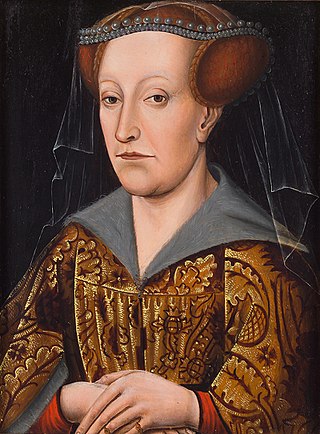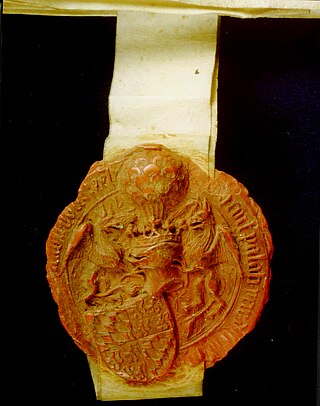Siege
By May 1428, Philip the Good had recruited a huge Burgundian army of 20.000 men and raised the siege of Gouda. Gouda was surrounded on three sides, only the river side remained under control of the fleet of Willem van Brederode. Jacqueline sent messengers to her allies Jan van Montfoort and Bishop of Utrecht Rudolf van Diepholt, but no help arrived. She could also not count on her English husband Humphrey, Duke of Gloucester, who had their marriage annulled.
After six weeks, and with no help on its way, Jacqueline had no choice but to surrender. She concluded the Treaty of Delft with Philip the Good of Burgundy on 3 July 1428. By this treaty, hostilities came to an end, Jacqueline retained her titles of Countess of Holland, Zeeland and Hainaut, but she recognized Philip as her heir and regent of her counties.

South Holland is a province of the Netherlands with a population of over 3.8 million as of January 2023 and a population density of about 1,410/km2 (3,700/sq mi), making it the country's most populous province and one of the world's most densely populated areas. Situated on the North Sea in the west of the Netherlands, South Holland covers an area of 3,308 km2 (1,277 sq mi), of which 609 km2 (235 sq mi) is water. It borders North Holland to the north, Utrecht and Gelderland to the east, and North Brabant and Zeeland to the south. The provincial capital is the Dutch seat of government The Hague, while its largest city is Rotterdam. The Rhine-Meuse-Scheldt delta drains through South Holland into the North Sea. Europe's busiest seaport, the Port of Rotterdam, is located in South Holland.

The Hook and Cod wars comprise a series of wars and battles in the County of Holland between 1350 and 1490. Most of these wars were fought over who should hold the title of "Count of Holland". The Cod faction generally consisted of the more progressive cities of Holland. The Hook faction consisted for a large part of the conservative noblemen.

Jacqueline, of the House of Wittelsbach, was a noblewoman who ruled the counties of Holland, Zeeland and Hainaut in the Low Countries from 1417 to 1433. She was also Dauphine of France for a short time between 1415 and 1417 and Duchess of Gloucester in the 1420s, if her marriage to Humphrey, Duke of Gloucester, is accepted as valid.

Albert I, Duke of Lower Bavaria, was a feudal ruler of the counties of Holland, Hainaut, and Zeeland in the Low Countries. Additionally, he held a portion of the Bavarian province of Straubing, his Bavarian ducal line's appanage and seat, Lower Bavaria.

John IV, Duke of Brabant was the son of Antoine of Burgundy, Duke of Brabant, Lothier and Limburg and his first wife Jeanne of Saint-Pol. He was the second Brabantian ruler from the House of Valois. He is best known for founding the University of Louvain (Leuven) in 1425.
The Battle of Brouwershaven was fought on 13 January 1426 in Brouwershaven, Zeeland. The battle was part of the Hook and Cod wars waged over control of the Low Countries and resulted in a significant victory for Philip the Good, Duke of Burgundy.

John III the Pitiless (1374–1425), of the House of Wittelsbach, was first bishop of Liège 1389–1418 and then duke of Bavaria-Straubing and count of Holland and Hainaut 1418–1425.

The Battle of Zwartewaal was a decisive naval battle during the Hook and Cod wars.

The Treaty of Delft, also called the Reconciliation of Delft, was signed on 3 July 1428 between Jacqueline of Bavaria and Philip the Good, Count of Flanders and Duke of Burgundy.

Alphen a/d Rijn railway station is a railway station in Alphen aan den Rijn, Netherlands.

The Boskoop railway station is a railway station in Boskoop, Netherlands, located on the RijnGouweLijn between Gouda and Alphen aan den Rijn. The railway station was opened on 7 October 1934 to transport the products of the local horticultural nurseries.

Leiden Lammenschans is a railway station in Leiden, Netherlands. The station, designed by Koen van der Gaast, was opened on 18 May 1961. It is served by trains running between Leiden Centraal and Utrecht Centraal, and by RijnGouweLijn trains running between Leiden Centraal and Gouda at peak hours.

Frank II of Borssele was a 15th-century Zeelandic nobleman.
The Treaty of The Hague is a treaty signed on 12 April 1433, in which Jacqueline, Countess of Hainaut transferred the Dutch territories of her Bavaria-Straubing inheritance to Philip the Good, Duke of Burgundy. Jacqueline had fought over the counties of Holland, Zeeland, Hainaut and Friesland since the death of her father William VI of Holland in 1417 first against her uncle John and then against duke Philip. In 1428, defeated by Philip, she was forced to sign the Treaty of Delft, which named Philip as her heir if she died without offspring and forbade her to remarry without the consent of Philip. In 1432, after she married Frank van Borssele, Philip claimed that the Treaty of Delft had been broken and demanded that Jacqueline abandon all her rights to him; the treaty of The Hague of 1433 formalized this abandonment. Jacqueline died just three years later. Her Dutch lands were eventually merged into the Habsburg Empire.

The Cod Alliance Treaty was a 1350 or 1351 treaty by which a number of nobles and cities allied with William V of Holland against his mother Margaret II, Countess of Hainaut and her allies. It was signed in the first phase of the Hook and Cod wars.

The Hook Alliance Treaty was signed during the first phase of the Hook and Cod wars in the County of Holland. By this treaty the Hook faction promised to support Margaret II, Countess of Hainaut against her rebellious son William of Bavaria.

The Battle of Veere was a small naval battle that took place in late May 1351 during the Hook and Cod wars.
Marieke van Amerom is a painter and draftsman from Alphen aan den Rijn.
The siege of Geertruidenberg (1351–1352) was a long siege of Geertruidenberg Castle during the first of the Hook and Cod wars.

The siege of Zierikzee (1351) took place during the first of the Hook and Cod wars.















